Mobil
Mobil, previously known as the Socony-Vacuum Oil Company, is a major American oil company that merged with Exxon in 1999 to form a parent company called ExxonMobil. It was previously one of the Seven Sisters that dominated the global petroleum industry from the mid-1940s until the 1970s. Today, Mobil continues as a major brand name within the combined company, as well as still being a gas station sometimes paired with its own store or On the Run. The former Mobil headquarters in Fairfax County, Virginia, was used as ExxonMobil's downstream headquarters[1] until 2015 when ExxonMobil consolidated employees into a new corporate campus in Spring, Texas.[2]
 | |
| Industry | petroleum industry |
|---|---|
| Founded | 1911 (as Standard Oil Company of New York, or SOCONY) 1963 (as Mobil) |
| Headquarters | , |
| Products | Gasoline Convenience store Some locations: Carwash Automobile repair shop |
| Parent | ExxonMobil Exxon Esso |
| Website | www |

History
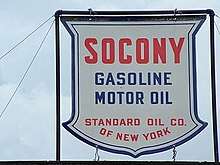
Following the break-up of Standard Oil in 1911, the Standard Oil Company of New York, or Socony, was founded, along with 33 other successor companies. In 1920, the company registered the name "Mobiloil" as a trademark.
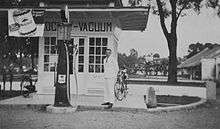
Henry Clay Folger was head of the company until 1923, when he was succeeded by Herbert L. Pratt. Beginning February 29, 1928 on NBC, Socony Oil reached radio listeners with a comedy program, Soconyland Sketches, scripted by William Ford Manley and featuring Arthur Allen and Parker Fennelly as rural New Englanders. Socony continued to sponsor the show when it moved to CBS in 1934. In 1935, it became the Socony Sketchbook, with Christopher Morley and the Johnny Green orchestra.
In 1931, Socony merged with Vacuum Oil to form Socony-Vacuum.[3]
In 1933, Socony-Vacuum and Jersey Standard (which had oil production and refineries in Indonesia) merged their interests in the Far East into a 50–50 joint venture. Standard-Vacuum Oil Co., or "Stanvac", operated in 50 countries, including New Zealand, China, and the region of East Africa, before it was dissolved in 1962. In 1935, Socony Vacuum Oil opened the huge Mammoth Oil Port on Staten Island which had a capacity of handling 250 million gallons of petroleum products a year and could transship oil from ocean-going tankers and river barges.[4]
In 1940, Socony-Vacuum's gasoline buying practices led to the major antitrust law case United States v. Socony-Vacuum Oil Co. The case originated with Socony-Vacuum's practices of organizing a cartel among the "major" oil companies in which they bought oil—known as "hot oil"—from independent producers and stored the surplus in tanks to limit the supply of oil available on the market and keep the price of oil artificially high. In its decision, the U.S. Supreme Court ruled that regardless of the purpose of the price fixing or if the prices varied, such conduct was illegal in and of itself: "Under the Sherman Act a combination formed for the purpose and with the effect of raising, depressing, fixing, pegging, or stabilizing the price of a commodity in interstate or foreign commerce is illegal per se..." This rule remains in use today for agreements that appear on their face to always or almost always restrict competition and reduce output.
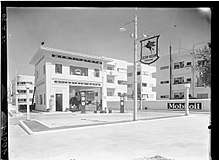
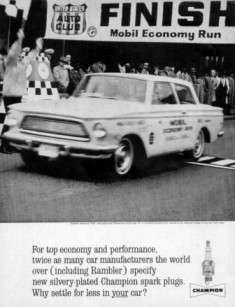
In 1955, Socony-Vacuum was renamed Socony Mobil Oil Company. In 1963, it changed its trade name from "Mobiloil" to simply "Mobil", introducing a new logo (created by New York graphic design firm Chermayeff & Geismar). To celebrate its 100th anniversary in 1966, "Socony" was dropped from the corporate name.
From 1936 to 1968, Mobil sponsored an economy run each year (except during World War II) in which domestic automobiles of various manufacturers in several price and size classes were driven by light-footed drivers on cross-country runs. The Economy Run originated with the Gilmore Oil Company of California in 1936 (which was purchased by Socony-Vacuum in 1940) and later became the Mobilgas Economy Run, and still later the Mobil Economy Run. The cars driven in the economy run were fueled with Mobil gasoline, and Mobiloil and lubricants were also used. The vehicles in each class that achieved the highest fuel economy numbers were awarded the coveted title as the Mobilgas Economy Run winner.
During American involvement in World War II, April 29, 1942, Socony's unescorted tanker, named Mobiloil, was sunk by a German U-boat (German Type IX submarine U-108 captained by Klaus Schlotz), and all 52 people survived after 86 hours adrift in lifeboats. Socony-Mobil ranked 86th among United States corporations in the value of World War II military production contracts.[5]
Through the years, Mobil was among the largest sellers of gasoline and motor oils in the United States and even held the top spot during the 1940s and much of the 1950s. Various Mobil products during the Socony-Vacuum and Socony-Mobil years included Metro, Mobilgas and Mobilgas Special gasolines; Mobilfuel Diesel, MobilHeat and Mobil-flame heating oil, Mobil Kerosine, Lubrite,[6] Gargoyle, Mobiloil and Mobiloil Special motor oils; Mobilgrease, Mobillubrication, Mobil Upperlube, Mobil Freezone and Permazone antifreezes, Mobilfluid automatic transmission fluid, Mobil Premiere tires, Mobil Stop-Leak, and Mobil Lustrecloth, among many others.
In 1954, Mobil introduced a new and improved Mobilgas Special in response to trends toward new automobiles powered by high-compression engines that demanded higher and higher octane gasolines. The newest formulas of Mobilgas Special were advertised as offering "A Tune-Up in Every Tankful" due to a combination of chemicals known as the "Mobil Power Compound" which was designed to increase power, check pre-ignition ping, correct spark plug misfiring, control stalling and combat gumming up of carburetors. Later Mobil campaigns advertised Mobilgas as the "New Car Gasoline" following extensive testing during the annual Mobilgas Economy Run.
In 1962, the gasoline product lines marketed as Mobilgas and Mobilgas Special were rebranded as Mobil Regular and Mobil Premium in a move to emphasize the shortened brand name "Mobil" in promotional efforts, although Mobiloil continued as a single-word term until the 1970s. After a few years of advertising Mobil gasolines as "Megatane"-rated and as "High Energy" gasolines, Mobil began, in 1966, to promote both its Regular and Premium fuels as "Detergent Gasolines", due to the inclusion of additives designed to clean carburetors and various internal engine parts. During the early 1970s, Mobil ran a TV commercial featuring a character known as "Mr. Dirt" to show the ruinous effects that dirt had on automotive engines for which a tank of Mobil Detergent Gasoline could provide a cure and preventive medicine against damage that could lead to costly repairs.
As automakers were switching en masse from carbureted to fuel-injected engines during the early to mid-1980s, and the detergent additives that existed in most available gasolines proved not to be enough to prevent injection clogging, leading to drivability problems, Mobil received accolades from General Motors and other automakers for increasing the detergency of its Super Unleaded gasoline in 1984 to prevent formation or deposit build-ups of the injectors but also remove existing deposits as well in normal driving. At the end of the 1980s Mobil sold its fuel stations in Norway, Sweden, and Denmark to Norsk Hydro, who converted them into Hydro stations.
William P. Tavoulareas was President of Mobil Corporation until succeeded by Allen E. Murray in 1984.

Mobil moved its headquarters from 150 East 42nd Street, New York City to Fairfax County, Virginia, in 1987.[7] That same year, Mobil sold nearly all of its stations in Western Pennsylvania (including Pittsburgh) to Standard Oil of Ohio (which had just been fully acquired by BP) and terminated franchise contracts with the rest of the stations in the area, withdrawing the Mobil brand from the area for 29 years until a Uni-Mart location in Coraopolis, Pennsylvania started selling Mobil gasoline in 2016.[8]
In 1998, Mobil and Exxon agreed on a merger to create ExxonMobil, which was completed on November 30, 1999. Lou Noto was Chairman of Mobil at the time of the merger, and Walter Arnheim was treasurer.[9]
Mobil brands
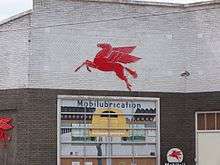
Mobil continues to operate as a major brandname of ExxonMobil within the ExxonMobil Fuels, Lubricants & Specialties division.[10] Many of its products feature the Mobil symbol of a winged red horse, Pegasus, which has been a company trademark since its affiliation with Magnolia Petroleum Company in the 1930s.
The Mobil brand now mainly covers a wide range of automotive, industrial, aviation and marine lubricants.[11] For historic reasons, the Mobil brand is still used by Mobil service stations and for fuel (gasoline, diesel, heating oil, kerosene, aviation fuels and marine fuel) products.
There are four main Mobil sub-brands:
Mobil Gasoline
Mobil is ExxonMobil's primary retail gasoline brand in California, Florida, New York, New England, the Great Lakes and the Midwest. The Mobil brand is also used to market gasoline in Australia, Canada (since 2017), Colombia, Egypt, Guam, Japan (until 2019), Malaysia (until 2012), Mexico (starting about first quarter of 2018), New Zealand and Nigeria.
The Mobil brand has a significant market presence in the following metropolitan areas:


- New York metropolitan area (excluding New Jersey)
- Detroit
- Chicago
- Los Angeles
- Minneapolis-St. Paul
- Boston
- Buffalo
- St. Louis
- Tampa-St. Petersburg
- Miami
- Rochester-Syracuse
- Orlando
- Milwaukee
- Providence
- Albany
- Hartford
Mobil stores have made an increased presence in Arizona. Growing in size in the Phoenix area from fewer than 5 stations to over 20. Mobil stores have also made an increased presence in areas of Northwest Oregon and Southwest Washington.
Exxon is the primary brand in the rest of the United States, with the highest concentration of Exxon retail outlets located in New Jersey, Pennsylvania, Texas (Mobil has a sizeable amount of stations in Dallas and Houston), Louisiana (mainly New Orleans as well as Baton Rouge) and in the Mid-Atlantic and Southeastern states. Esso is ExxonMobil's primary gasoline brand worldwide. Both the Esso and Mobil brands are used in Canada (since 2017),[12] Colombia, Egypt, and formerly Japan and Malaysia, in which the latter were rebranded as Petron in 2013, and ENEOS for the former in 2019, separately. In Esso stations in Hong Kong and Singapore, the Mobil brand is used on fuel tanks, along with Esso.
Mobil 1
Mobil 1, the successor to the Mobiloil brand, is a brand name of ExxonMobil. It was introduced in 1974 as a Multi-grade 5W20 viscosity synthetic motor oil. The brand now includes multi-grade motor oils, oil filters, synthetic grease, transmission fluids, and gear lubricants.[13] The Esso and Exxon motor oil brands have largely been discontinued.
Mobil Delvac
Mobil Delvac is a range of heavy-duty lubricants designed for commercial vehicles. The range includes engine oils, transmission fluids, drivetrain lubricants and various greases.[14]
Mobil Industrial
Mobil Industrial is a sub-brand of ExxonMobil for marketing oils and greases used in industrial applications. The main product lines are Mobil SHC synthetic oils and Mobil Grease greases.[15]
Former Mobil brands
Discount gasoline stations
Mobil rebranded numerous stations to the Hi-Val, Reelo and Sello discount gasoline brands after major price increases following the 1970s oil crisis made a significant number of consumers extremely price conscious. The stations were converted Mobil stations selling convenience store items in the station lobby, while the service bays were rented to customers for do-it-yourself auto repairs. These brands were discontinued in the 1980s, after the gasoline market had recovered.[16]
Convenience Stores
Mobil expanded the sale of convenience store items first pioneered at its discount gasoline stations under the Mobil Mart brand. Mobil continued to refine and enhance its convenience store offerings with the On-the-Run C-store brand, which proved to be much more popular. On-the-Run was sold to Alimentation Couche-Tard, operator of the Circle K convenience store chain. Some On the Run locations were sold to 7-Eleven.
Mobil Travel Guide
The Mobil Guide was an annual book of hotel and restaurant recommendations based on a system developed by Mobil in 1958. It rated businesses from one to five stars according to their assessed quality. In October 2009, ExxonMobil licensed the brand to Forbes magazine, which retitled the guide's various designations, e.g., Forbes Travel Guide, Forbes Five Stars, and so on. Forbes launched revised versions of various guides in late 2009.[17][18]
Lukoil transaction
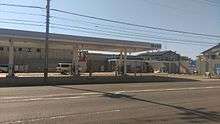
In 2000, Lukoil purchased the remaining assets of Getty Oil and began opening Lukoil stations in the US in 2003. Most of the US Lukoil locations are converted Getty stations, although some are also converted Mobil stations bought from ConocoPhillips when that company left the Northeast.
In spring 2004, Lukoil purchased 779 Mobil gas stations throughout New Jersey and Pennsylvania, and in 2005 began converting them to the Lukoil brand. Most New Jersey Mobil locations were converted to Lukoil stations.
Mobil UK
Vacuum Oil Company started selling lubricating oils in Europe in the late 19th century. By the 1930s its Mobiloil had become one of the main brands. Mobil gradually expanded its operation into fuels retailing as well, and opened its first UK service stations in the early 1950s, after the wartime POOL monopoly was disbanded. Mobil grew to become the seventh largest brand of petrol in Britain, supplying 1,990 outlets in 1965, and claimed in the mid-1960s to be the first company to operate 100 self-service stations. As well as its downstream interests, Mobil was active in the North Sea and operated an oil refinery in Coryton (opened in 1953), on the Thames estuary. In 1996, Mobil's fuels operations in Europe were placed into a joint venture 70% owned by BP, and the Mobil brand disappeared from service stations. Mobil continued to sell lubricants through BP and independent service stations. Following Mobil's merger with Exxon, at the start of 2000 BP acquired all the petrol retailing assets as well as the Coryton refinery (but sold it to Petroplus in 2007). Mobil returned to being purely a lubricant brand in Europe, and became the premium quality oil on sale at Esso service stations.
Mobil Australia
The Vacuum Oil Company began operating in Australia in 1895, introducing its Plume brand of petrol in 1916. The Flying Red Horse (Pegasus) logo was introduced in 1939, and in 1954, the Plume brand was replaced by Mobilgas.
Mobil Australia's corporate office is in Melbourne. In 1946, Mobil began construction of its refinery at Altona, in Melbourne's western suburbs, which originally produced lubricating oils and bitumen, before commencing the production of motor vehicle fuels in 1956. A second refinery at Port Stanvac, south of Adelaide, came on-stream in 1963, but was closed in 2003.[19] Mobil commenced removal of the refinery in July 2009, together with site remediation works.[20]
In 1990, Mobil acquired the service station network of Esso Australia. On 27 May 2009, Caltex Australia announced it would be acquiring 302 Mobil service stations in Melbourne, Brisbane, Sydney and Adelaide, subject to approval of the Australian Competition & Consumer Commission.[21] The ACCC subsequently announced its opposition to the takeover, citing the likelihood of increased fuel prices due to diminished competition.[22]
On 27 May 2010, 7-Eleven announced that it had acquired Mobil's entire Australian network of 295 service stations, with fuel still to be supplied by Mobil. At the same time, it was announced that 7-Eleven had sold 29 South Australian service stations to Peregrine Corporation. Peregrine's acquisition saw Mobil's sites in South Australia rebranded to On the Run convenience stores, but they continued to be supplied by Mobil. 7-Eleven store renovations and openings since 2013 have included prominent placement of the Mobil logo (as the advertised fuel supplier), usually underneath the 7-Eleven logo, on main signage as well as on petrol pumps.[23]
Mobil New Zealand
Mobil is the oldest oil company in New Zealand with commercial operations dating back to 1896. It first began operating in New Zealand under the Standard Oil brand name selling kerosene in the 1870s. Early in 1896, Vacuum Oil of New York established a marketing office on Featherston Street in Wellington selling lamp oil and harness grease. It brought with it extensive collective production, marketing and management skills that presented a major advancement in business organisation. The company's unrivaled mineral lubricant products and associated services quickly dominated the market.
When New Zealanders began taking to the motorcar in the early twentieth century, Vacuum Oil expanded into the oil refining business. Its marketing network and transportation fleet grew as it extended its range of operation. The company continued to meet New Zealand's fuel needs throughout World War One holding roughly eighty five percent of the market. However, after the war Vacuum Oil began facing very strong competition from a number of multinational oil companies which began setting up operations in New Zealand. Among these competitors was the Atlantic Union Oil Company, another of ExxonMobil's historical companies.
Atlantic Union was bought by the New Jersey-based Standard Oil Company, which would later become Exxon, and its eastern hemisphere interests were merged with those of Socony-Vacuum Oil Company to create the Standard-Vacuum Oil Company. The new company continued operations in New Zealand under both the Vacuum and Atlantic Union brand names.
On November 30, 1999, Exxon Corporation and Mobil Oil Corporation merged with Mobil Oil New Zealand Limited now owned by new entity ExxonMobil. The company currently owns a 17.2 percent share in The New Zealand Refining Company Limited which operates an oil refinery at Marsden Point near the city of Whangārei. It supplies roughly twenty percent of the total fuels market in New Zealand which most of its products sourced from the Marsden Point refinery. Mobil Oil New Zealand Limited operates over one hundred and fifty locations across the country either as Mobil-owned stations or as franchises. It also operates six storage locations across the country maintaining a reputation as a dominant petroleum company in New Zealand.[24] [25][26]
Mobil Greece
The first petrol station of Mobil in Greece opened on March 4, 1955. Up until 1970 had opened about 100 petrol stations of the company. On March 1, 1999 Mobil closed its remaining petrol stations in Greece.
Mobil in Japan
Since the 1960s, Esso and Mobil stations in Japan had been run by Tōnen General Sekiyu, which had a controlling stake owned by ExxonMobil. In 2012, the company bought out much of ExxonMobil's stake, reducing it to a 22% minority. In 2016, ExxonMobil sold the remainder of its stake.[27]
In 2017, the company announced that it would merge with JX Group to form JXTG Holdings, with its petroleum business operating as JXTG Nippon Oil & Energy. Following the merger, it was announced that both the Esso and Mobil brands would be phased out by 2020, and replaced by the JX-originated Eneos banner.[28]
Mobil in Canada
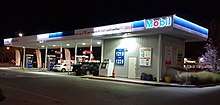
In April 2017, Loblaw Companies sold its network of 213 gas stations (all of which are attached to its various grocery store locations) to Brookfield Business Partners. Brookfield announced that it would license the Mobil brand from ExxonMobil for use on these locations, making them a sister to Imperial Oil's network of Esso-branded gas stations in Canada. As part of the sale agreement, the Mobil stations continue to offer Loblaw's PC Optimum rewards program (which Esso also joined the following year).[29][30]
Brookfield stated that it would open further Mobil stations beyond the Loblaw properties.[31]
Mobil Egypt
In Egypt, ExxonMobil's operations started in 1902, it is known for providing quality lubricants and fuels as well as convenience products. It offers more than 350 service stations, more than 40 Mobil 1 centers and a variety of industrial products, lubrication programs and services. Some stations in Cairo, Alexandria and Giza feature On the Run convenience stores.[32][33]
See also
- Mobil Showcase Network
- Previous headquarters buildings
References
- "Mobil Corporation". Americancompanies.com. Archived from the original on 2010-09-15. Retrieved 2010-07-25.
- "Our Houston campus". Exxonmobil.com. Retrieved 2015-10-01.
- "Business & Finance: Socony-Vacuum Corp." Time, 1931-08-10, retrieved on 2009-12-10.
- Magazines, Hearst (1 October 1935). Popular Mechanics. Hearst Magazines. p. 543. Retrieved 20 July 2018 – via Internet Archive.
Popular Science 1935 plane Popular Mechanics.
- Peck, Merton J. & Scherer, Frederic M. The Weapons Acquisition Process: An Economic Analysis (1962) Harvard Business School p.619
- "Lubrite Technologies". Usbfmi.com.
- Dawson, Jennifer (January 15, 2010). "Exxon Mobil campus 'clearly happening'". Houston Business Journal. Retrieved 24 July 2010.
- "Toledo Blade - Google News Archive Search". news.google.com.
- Myerson, Allen R. (4 December 1998). "The Lion and the Moose - How 2 Executives Pulled off the Biggest Merger Ever". The New York Times. Retrieved 24 July 2010.
- "ExxonMobil Press Release" (PDF). ExxonMobil.com. Retrieved 2012-04-03.
- "Lubricants". Mobil.com. Retrieved 2012-04-03.
- "Archived copy". Archived from the original on 2018-04-29. Retrieved 2018-04-29.CS1 maint: archived copy as title (link)
- "Mobil 1™ and Mobil Super™ motor oil and synthetic motor oil - Mobil™ Motor Oils". Mobiloil.com.
- "Mobil Delvac". ExxonMobil. Retrieved 2017-04-02.
- "Mobil Industrial website". MobilIndustrial.com. Retrieved 2012-04-03.
- Dr. James B. Delaney and Dr. Robert N. Fenili (May 1980). "The State of Competition in Gasoline Marketing: The Effects of Refiner Operations at Retail". United States Department of Energy.
- "Mobil Travel Guide to become Forbes Travel Guide". Associated Press. 2009-08-04.
- Carly Zinderman (2009-12-03). "Hotel Rankings: Forbes Merges with Mobil". International Business Times. Archived from the original on 2009-12-08.
- "Jamieson oil industry history". Home.austarnet.com.au. Retrieved 2010-07-25.
- "Mobil news". Exxonmobil.com.au. 2009-06-25. Retrieved 2010-07-25.
- Durie, John (May 27, 2009). "Caltex pumps for control". The Australian. Archived from the original on June 1, 2009. Retrieved 2010-07-25.
- Freed, Jamie, "Watchdog blocks Caltex bid", Sydney Morning Herald, retrieved 2009-03-12
- "Exxon Mobil sells service station network". The Australian. 27 May 2010. Retrieved 27 May 2010.
- "Mobil Oil New Zealand Limited is New Zealand's oldest oil company, with predecessor companies having first established a presence in the country in 1896". ExxonMobil.
- "ExxonMobil subsidiaries have a business history in New Zealand stretching back more than 120 years. We are involved in petroleum refining and distribution and the marketing of fuels, lubricants and chemical products". ExxonMobil.
- "Archived copy". Archived from the original on 2016-08-13. Retrieved 2016-06-27.CS1 maint: archived copy as title (link)
- Merced, Michael J. de la (January 29, 2012). "Exxon Mobil to Sell Its Japanese Arm for $3.9 Billion". The New York Times. Retrieved December 4, 2018.
- "Gas station merger will end Esso and Mobil's long run in Japan". Nikkei Asian Review. Retrieved 2018-12-04.
- "Esso moves to affiliate itself with PC Optimum, no longer Aeroplan, in loyalty point switch". CBC News. Retrieved 2018-03-14.
- "Mobil brand of gas stations to launch in Canada after deal for 213 Loblaws-owned locations". CBC News. Retrieved 2017-10-28.
- "Mobil Nears Completion of Rebranding 200 Loblaw Gas Stations". Retail Insider. Retrieved 2018-10-06.
- "Learn about ExxonMobil's operations in Egypt". ExxonMobil.
- "Petrol and Diesel Service Stations in Egypt - Mobil". fuels.mobil.com.eg.
External links
| Wikimedia Commons has media related to Mobil. |